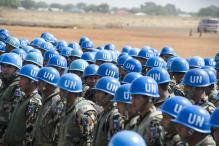International security cooperation is on the wane. The post-Cold War period saw the rapid establishment of new norms and organizations to manage the risks of conflict, coupled with the revitalization of existing bodies such as the United Nations. The resulting international security architecture is incoherent, spanning countless multilateral treaties and mechanisms, but still impressive. At no previous point in history have states sustained such a broad and complex set of security arrangements. Yet in the fifteen years since the Iraq War, these arrangements and the norms that underpin them have gone into an extended decline that appears to be accelerating.
What will be left of the post-Cold War security system by 2030? This question invites a lot of excitable speculation. It is possible to imagine several plausible catastrophic events, such as a major power war between the US and China or a nuclear exchange, that would profoundly disrupt international cooperation. Such massively disruptive events could spell the end of current international security institutions, just as the Second World War killed off the League of Nations. But they could also conceivably force radical reforms of bodies like the UN to stop the world from falling apart completely.
Gaming out such scenarios has some educational value, and even some entertainment value to those who find geopolitics fun. But the history of prognostications about the future of war and peace shows that forecasters are generally wrong about what comes next. Rather than attempt to predict the unpredictable, this essay will focus on the implications of the degeneration of the post-1989 security architecture and ask what policy-makers can do in the next decade to reverse or adapt to this trend.
We will focus on three notable features of the post-1989 order and their decline:
- Mutual intrusion: One of the most striking aspects of the post-Cold War settlement was the willingness of states to open their security capabilities to scrutiny by other powers and construct a strong legal framework for these interactions. The US its allies and former adversaries signed documents such as the Conventional Forces in Europe (CFE) and Open Skies Treaties that gave each other unprecedented insights into their military dispositions and scientific capabilities. As the former British diplomat Robert Cooper emphasized in the late 1990s, this was an “extraordinary revolution” that opened the way to a “postmodern” international order in which states agreed to base their security relationships on mutual openness and reassurance
- Cooperative interventions: A second remarkable feature of the post-1989 moment was broad-based agreement on the need to intervene in conflict-affected states. This statement may sound curious, as a series of Western interventions – including those in Kosovo and Iraq – created enormous anger and mistrust between states. But, as Stephen John Stedman and I have recently noted, these controversial cases were exceptions to a wider rule. In contrast to the Cold War era, in which the US and USSR turned civil wars and regional conflicts in the Third World into proxy conflicts, states have regularly taken a cooperative approach to conflict resolution. This has morphed into a “standard treatment” for many civil wars, involving mediation plus the deployment of international peacekeeping forces and international aid to make peace deals stick.
- International institutions: The organizational corollary of the rise of mutual intrusion and cooperative interventionism was the growth of international institutions to manage these new forms of inter-state engagement. This included both the refashioning of existing entities, as in the expansion of the UN machinery for overseeing peace operations and NATO’s rebranding as a crisis management body in the Balkans and Afghanistan, and the invention of new bodies to oversee agreements, such as the Organization for the Prohibition of Chemical Weapons (OPCW).
These three features of the post-1989 settlement connected to other trends, including the reduction of the nuclear powers’ stockpiles and the far-reaching extension of “mutual intrusion” into realms such as human rights and the rule of law (or even, in the European Union, almost every aspect of political and economic life). Some observers held that the refashioning of the international security architecture wrought deeper changes in the way states felt about another. Tracing the development of the CFE Treaty, which set limits on NATO and Warsaw Pact deployments and permitted both sides to launch challenge inspections of the other’s forces, Cooper observed “it embodied the idea of balance between opposing blocs." This assumed that the members Alliance and the Pact were still enemies, “but by the time balance and transparency have been achieved, it is difficult to retain enmity.” From the perspective of the late 1990s, it seemed possible that the post-1989 settlement could create a new community of trustful nations, although Cooper himself was never sure this “postmodern” system could include “modern” states such as India or “premodern” fragile states.
Two decades later, these aspirations ring hollow. Even the countries that invested most in cooperation – such as the members of EU – suffer perennial bouts of mistrust. There has also been an observable decline in consensus around the value of intrusion, interventions, and institutions.
The 2003 Iraq war was a pivotal moment in this process, although American analysts sometimes underestimate its impact on international attitudes. The Bush administration’s approach to Iraq disregarded all three dimensions of the international security system highlighted above. While Baghdad assented to international inspections to prove it no longer retained weapons of mass destruction – submitting to the norm of intrusion – Washington ignored the inspectors’ findings. It also misused arguments in favor of interventionism to justify the invasion of Iraq and highlighted the weakness of international institutions by acting without the final approval of the Security Council.
The Iraq War alone might not have invalidated the norms and institutions of the post-Cold War settlement. In the years following the invasion, US allies and other powers made a determined effort to persuade Washington of the value of the international order. The Obama administration largely bought into these arguments. But a series of further crises, ranging from the 2008 financial emergency to the Libyan and Ukrainian wars, shook up international power relations and sowed mistrust among the US and other states, setting the stage for the fall of the post-1989 settlement.
The decline of transparency
The CFE Treaty, once an exemplar of international transparency, also exemplified its deterioration. In 2007, Russia suspended participation in the treaty over disputes with NATO about the frozen conflicts in Moldova and Georgia, exacerbated by Moscow’s opposition to the US plans for missile defenses in Europe. In 2014, it withdrew from the treaty completely in the heat of the Ukrainian war.
But the decline of transparency in international security affairs extends well beyond the European case. The emergence of a new generation of weaponizable technologies – including cyberweapons, drones, robotic weapons systems and Artificial Intelligence (AI) – has created incentives for states to be secretive about their capabilities and intentions. Powers including the US, China and Russia, have hurried to develop and deploy these new tools in the absence of clear arms control frameworks to regulate their use. International efforts to construct such frameworks have foundered. In 2004, for example, the UN set up a Group of Governmental Experts (GGE) to discuss cybersecurity. As Stefan Soesanto and Fosca d’Incau note, this initiative harked back to earlier arms control initiatives such as the Non-Proliferation Treaty and Chemical Weapons Convention, “firmly grounded in the belief that diplomatic consensus can shape state behavior in cyberspace.” Despite progress on mapping an agenda for discussions on cyber issues, the GGE process broke down in 2017 over a dispute between Western powers and Russia and China over what laws apply to cyberwarfare.
International officials such as UN Secretary-General António Guterres and influential individuals such as the technology magnate Elon Musk have called on states to discuss multilateral constraints on AI and robotic weapons systems. Yet given the mistrust between the major powers, and the possibility that new technologies could decisively alter the balance of military power, it is hard to see states opening up to mutual intrusion over their programs or placing strong legal limits on their use.
The decline of cooperative interventions
If there is less consensus over the need for transparency in security affairs, there has been a parallel diminution in support for cooperative interventionism. This is by no means complete. The US and other states have continued to support international mediation efforts and peace operations in cases ranging from South Sudan to Colombia. Nonetheless, these have been overshadowed by rifts between the big powers over the conflicts in Libya, Syria, Ukraine, and Yemen. These splits have made the “standard treatment” approach to peacemaking identified by Stedman and this author virtually impossible, and severely raised the human costs of the wars involved. There is broader evidence of an increase in the internationalization of civil wars (the deployment of foreign forces on one side or another, rather than as peacekeepers) and of conflicts lasting longer than in the previous decade.
While diplomats trade blame over these crises in the Security Council and other forums, Barry R Posen has recently made a powerful case that it is an inevitable byproduct of an increasingly multipolar order. “The great powers will be more concerned about other great powers,” he notes, “which should make civil wars generally less important to them and thus make early preventive intervention less likely." In those cases where the powers do perceive that their interests are at stake in a conflict, they are more likely to take a competitive rather than a cooperative approach to the problem, boosting their proxies and only accepting peace agreements that serve their own interests.
This vision of a decline in cooperative crisis management is partially off-set by two factors. The first is the rise of regional peace efforts, such as the African Union’s efforts in Darfur and Somalia and Cuba’s sponsorship of the Colombian process, which partially vitiate a lack of great power consensus. The second is that, even in cases where such regional cooperation is lacking such as in Syria, external actors have put aside their differences temporarily to tackle transnational terrorist groups. But, as the Syrian case also demonstrates, this sort of short-term counter-terrorist collaboration is no substitute for real cooperation towards a political solution. It can even make an ugly conflict worse.
The decline of international institutions
Just as the international emphasis on mutual intrusion and cooperative interventionism in the post-Cold War moment spurred the growth of international institutions, the weakening of these norms has had a deleterious effect on the UN and other multilateral organizations. Again, this is far from complete. The UN’s members have managed to forge some far-reaching, although legally quite weak, agreements in recent years including the Paris climate change agreement and the Sustainable Development Goals. The organization’s security organs have been markedly under-performing by comparison. The Security Council has repeatedly become deadlocked over Syria, UN peacekeeping forces have struggled to impose order in trouble-spots such as Mali and the Democratic Republic of Congo, and humanitarian agencies lack the resources to keep up with all the crises on their agendas.
Similar patterns have affected other institutions that gained prominence in the early 1990s, such as the Organization for Security and Cooperation in Europe (OSCE). Whereas this body was highly active in the Balkans, Caucasus, and even in Chechnya in the post-Cold War decade, differences between Moscow and the West placed hefty constraints on its operations from roughly 2001 onwards. The OSCE has enjoyed an unexpected return to prominence during the Ukrainian crisis, deploying monitors in the Donbas and offering a remarkably detailed view of the war there. This is a notable achievement for a body most observers had written off as half-dead, but it is not clear that this one-off arrangement presages a broader revitalization of the institution or is rather its very last hurrah.
Tracking such multilateral trends, even advocates of international cooperation increasingly focus on orchestrating responses to crises through non-institutional channels. In a 2015 report, for example, the International Crisis Group (ICG) noted that when the early warning organization was founded in the mid-1990s, "the US, its allies, and the UN appeared to dominate the field [of conflict prevention.]” Two decades on, “a diverse array of mutually mistrustful states, organizations and non-governmental groups are engaged.” ICG’s solution is to promote “framework diplomacy” around individual crises: “painstaking efforts to establish case-specific mechanisms for managing, analyzing and mediating conflicts.” The weakness of international institutions is now even a commonplace theme inside some of the institutions themselves. A joint study by the UN and World Bank published in early 2018 highlights the limitations of existing conflict management tools such as peacekeeping and argues for more international investment in countries’ “endogenous” capacities to prevent and handle crises.
A security safety net?
What do these current negative trends in international security cooperation tell us about the potential shape of the international security architecture in 2030? It is necessary to repeat our opening admonition against excessively bold predictions. What seems to matter in international security at one moment can appear quite irrelevant a decade or so later. As Andrew Webster has observed, security specialists at the start of the 1930s genuinely believed that the World Disarmament Conference of 1932 under the auspices of the League of Nations could be transformative, for example, but the events of the ensuing decade erased it from popular memory.
We cannot be sure that the current erosion of international norms and security institutions will necessarily seem relevant in 2030. But if these trends continue – without a major disruptive event such a nuclear exchange intervening with unforeseeable results – we would be likely to observe:
- Opaque security diplomacy: Trapped in an ongoing race to gather intelligence on each other’s military technological programs, governments are liable to avoid revealing even very limited information about their capabilities and intentions through formal transparency agreements. At best, they will signal their capabilities to one another through other channels. Soesanto and d’Incau suggest that states respond to the breakdown of GGE discussions on cyberspace through “the creation of national red lines, military doctrines, and diplomatic response frameworks, which could in time become the building blocks of future bi- and multilateral agreements.”
- Confused and competitive interventionism: With the apparent decline of the “standard treatment” for civil wars and other conflicts, states will deal with conflicts on a haphazard fashion, find reasons for limited cooperation in some cases and outright competition in others. Posen recommends that “rather than assuming agreement, or the potential for agreement, among ideologically like-minded powers, diplomats may need to return to a more traditional approach of finding elements of agreement among powers who largely see themselves in a competitive relationship.” But at times this quest will fail, making further Syria-type proxy wars more likely.
- Ad hoc responses to security threats: Given the decline of international security cooperation, international institutions will regularly be sidelined. Where any sort of crisis response is feasible, it will generally involve regional organizations like the AU; one-off coalitions resulting from smart “framework diplomacy”; successfully harnessing “endogenous” crisis management capacities within states; or some lucky mixture of all three, with highly varied and imperfect results.
In short, the optimal model for international security cooperation in 2030 may be muddling through.
This does not necessarily mean reverting to the worst periods of twentieth century international competition. But the risks of miscalculations, misunderstandings and miscommunications between states is liable to rise. In addition to highlighting the general dangers associated with new technologies, Secretary-General Guterres has recently emphasized his specific concern that Russia and the US do not have “mechanisms for communication and control” comparable to those of the Cold War and called on Washington and Moscow to rebuild systems for “guaranteeing effective communication [and] guaranteeing capacity to prevent escalation.” Guterres was speaking in the context of incidents arising from frictions between US and Russian forces in Syria. But his appeal could equally apply to potential friction between the US and Russia over a cyber incident, tensions over AI or other new security threats. And with a few contextual tweaks, it could also apply to other pairings of antagonistic powers, such as the US and China, India and Pakistan or Israel and Iran.
If the post-Cold War moment saw states shift towards an unusually institutionalized set of arrangements for managing mutual intrusion and cooperative interventions, international security in 2030 could rely more on a “safety net” of inter-state mechanisms to allow governments to manage competition and limit unavoidable confrontations. Formal institutions such as the UN might have a reduced but still useful function to play in such a complex environment, rather as the OSCE whirred back to life unexpectedly to mitigate the conflict in Ukraine. But their contribution to international security would certainly be considerably less than has been the case in the last twenty-five years.
Is this scenario unavoidable? There is a chance that, contrary to the pessimistic argument here, states will pay heed to calls for new international mechanisms to limit and regulate new military technologies. It is also possible that major powers will eventually settle on new norms of conflict management: Chinese scholars and officials have underlined that they see UN peace operations as a possible area for cooperation with the West, possibly offering a new lease of life to the “standard treatment” of civil wars. But even optimists must recognize that the majority of available evidence suggests that the post-Cold War mixture of mutual intrusion, cooperative interventionism and international institutions are in retreat. Even without a deep shock to the global system like a major power war or atomic explosion, there will be less international security cooperation in 2030 than today. And this gradual erosion of cooperative mechanisms in turn makes major shocks more likely.
This article was first published in The Fletcher Forum of World Affairs.



